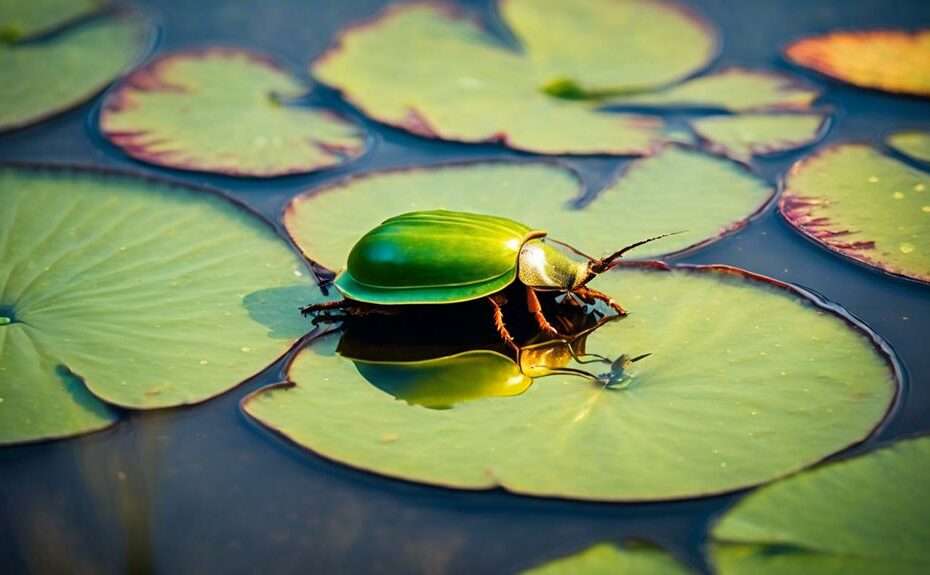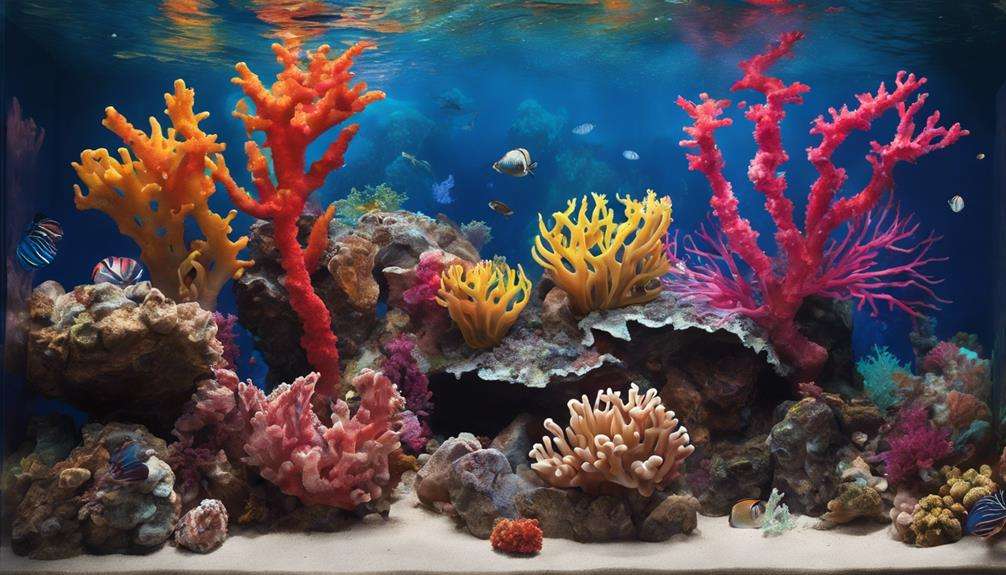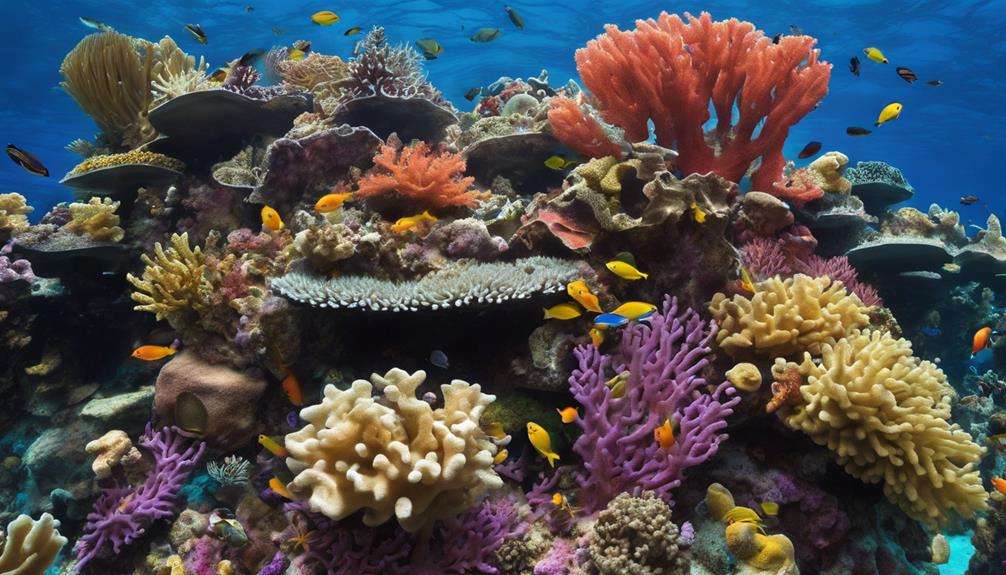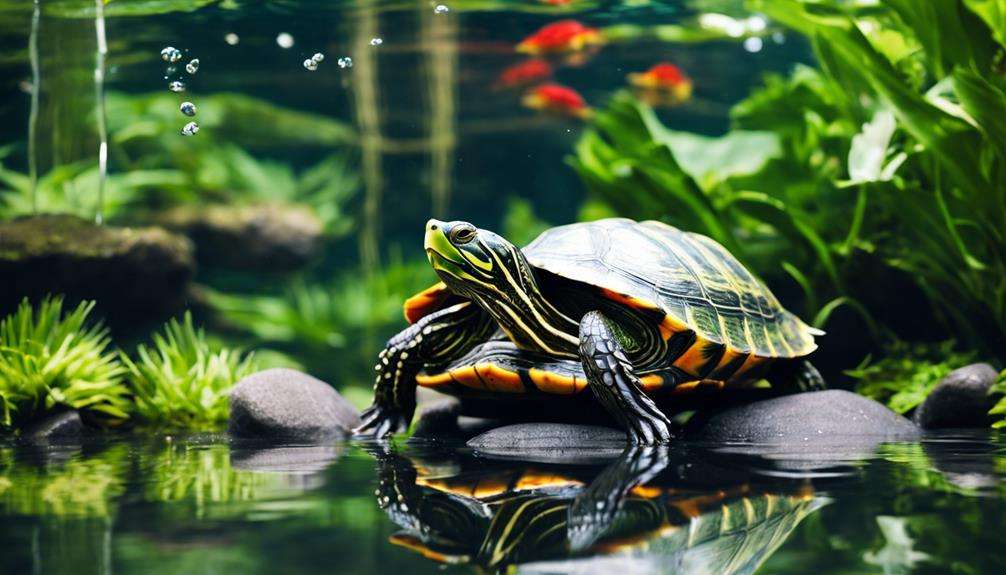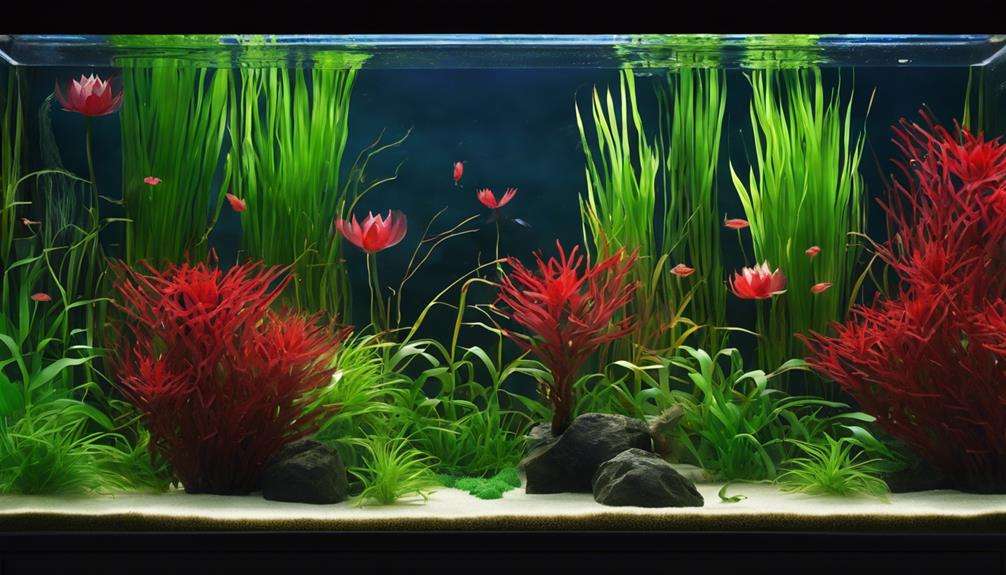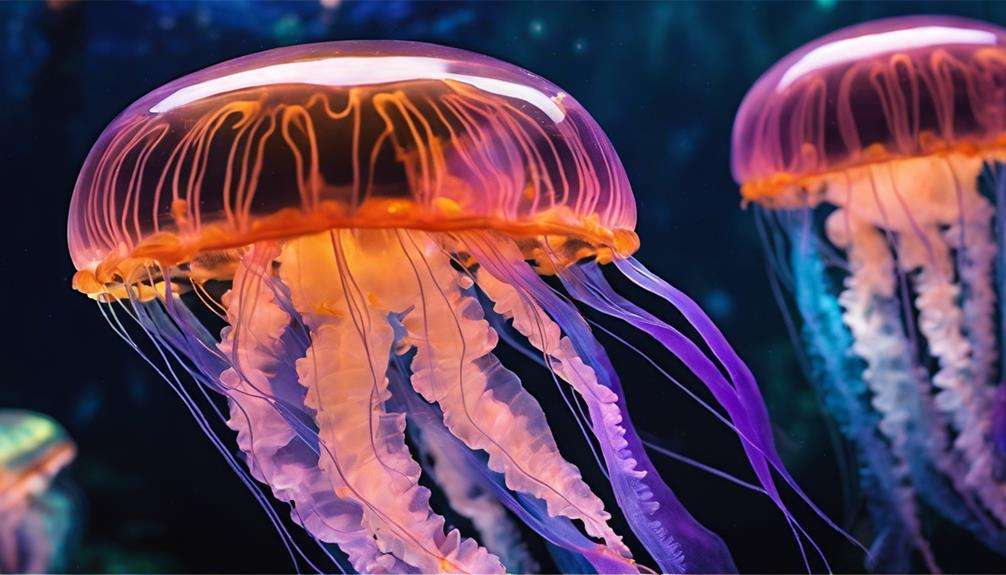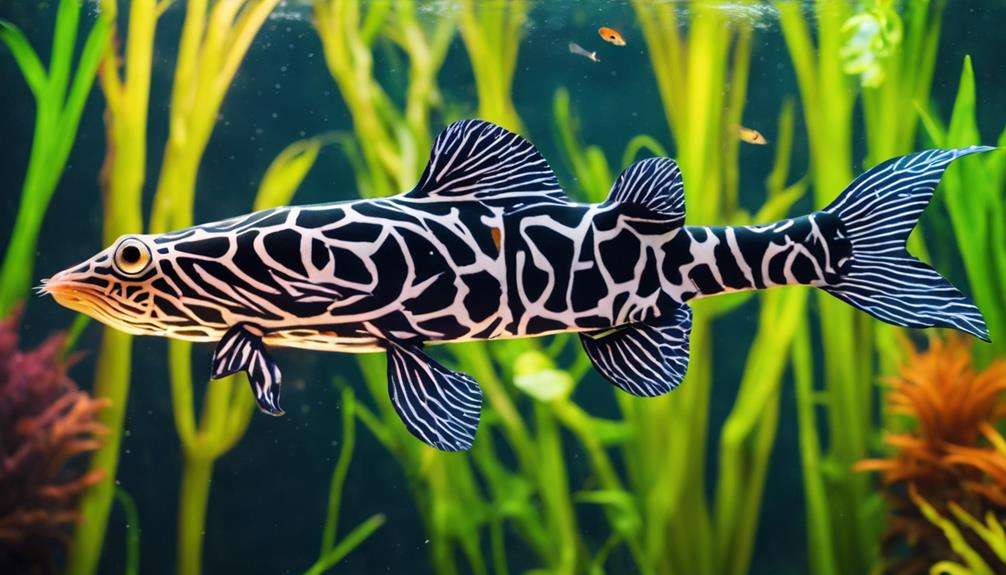Imagine stepping into the mesmerizing world of water beetles, where these tiny creatures navigate aquatic realms with grace and efficiency. From their intricate adaptations to their diverse species, water beetles offer a wealth of knowledge waiting to be uncovered.
Exploring their unique characteristics and behaviors can open doors to a deeper understanding of these fascinating insects, shedding light on their significance in the natural world. As you start on this journey of discovery, prepare to be captivated by the secrets these intriguing water beetles hold and the wonders they can reveal about life beneath the surface.
Key Takeaways
- Water beetles exhibit diverse behaviors and adaptations for survival.
- Providing a varied diet and stimulating habitat ensures their health and happiness.
- Reproduction involves aquatic mating, egg-laying, and parental care in some species.
- Maintaining stable environmental conditions is crucial to prevent health concerns and ensure their well-being.
Types of Water Beetles
Water beetles, with their diverse adaptations and unique characteristics, encompass a fascinating array of species, each exhibiting distinct behaviors and physical traits. Among aquatic beetles, there are several notable types.
Whirligig beetles, belonging to the family Gyrinidae, have divided eyes that allow them to see both above and below the water's surface simultaneously. These beetles are known for their swift movements and ability to live on water surfaces.
Dytiscidae diving beetles, characterized by their dark brown coloration and sharp pincers, excel in diving underwater and preying on other aquatic organisms. In contrast, Haliplidae beetles swim poorly and often opt for crawling, showcasing the varied locomotion strategies present in water beetle species.
Noteridae beetles, with their small size and smooth oval bodies, highlight the diverse physical characteristics found among water beetles. Lastly, the Amphizoidae Trout-Stream beetles have adapted to thrive in high mountain streams, demonstrating their specialization in specific freshwater habitats for survival.
Each type of water beetle offers unique insights into the fascinating world of aquatic insects.
Care and Maintenance Tips
Maintain a water depth of at least ten inches to ensure proper living conditions for your water beetles.
It's vital to provide a varied diet including crickets, waxworms, and other suitable prey items for their health and vitality.
Creating a habitat with live aquatic plants and gravel will help simulate a natural environment, promoting the well-being of your fascinating pets.
Feeding and Diet
To guarantee the prime health and vitality of your water beetles, providing a diverse and balanced diet is essential for their well-being in captivity. Water beetles thrive on an aquatic, varied diet that includes crickets, waxworms, earthworm pieces, brine shrimp, blackworms, prawn, fish, tropical fish flakes, and freeze-dried foods. These ravenous eaters aren't picky and readily accept a diverse range of food sources.
A varied diet is important for their health and well-being. By offering a mix of live and commercially available foods, you can assure that the nutritional needs of your water beetles are met in captivity. Remember, a well-fed water beetle is a healthy and happy water beetle!
Habitat Setup
Maintaining a secure and stimulating habitat for your water beetles involves meticulous care and attention to detail. The beetle aquarium must be tightly covered to prevent escapes and maintain a secure environment.
To create a natural habitat, include live aquatic plants and sticks in the tank for the beetles to cling to submerged objects. Keeping mild water movement is important to simulate the beetles' preferred pond and sluggish stream environments.
Keep environmental conditions stable with a temperature range of 70-82°F and a pH level between 6.8 and 7.5. Offer a varied diet, including crickets, earthworm pieces, brine shrimp, and tropical fish flakes, to meet the diverse feeding habits of diving beetles.
Feeding Your Water Beetle
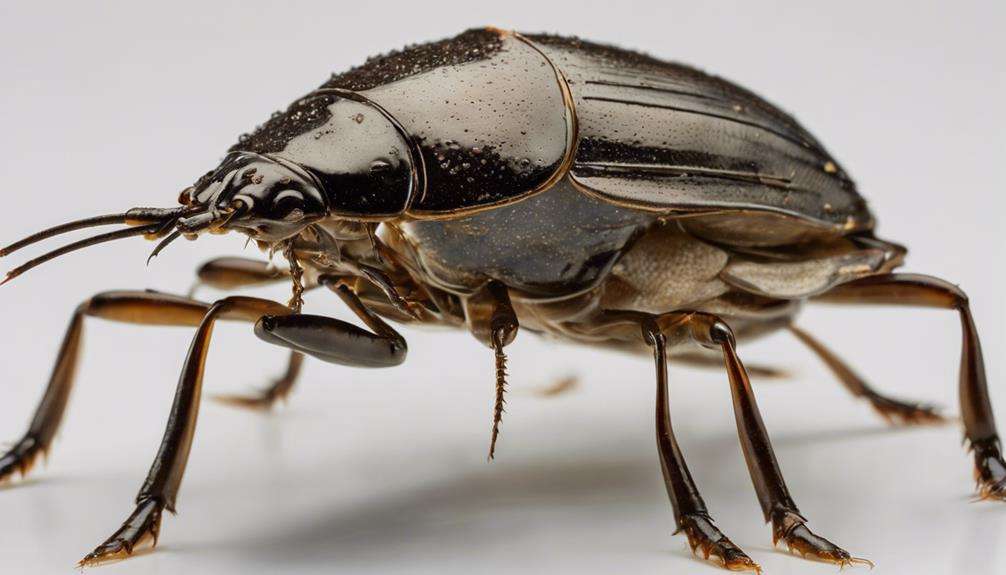
When caring for your water beetle, providing a diverse diet that includes crickets, waxworms, earthworm pieces, brine shrimp, blackworms, prawn, fish, tropical fish flakes, and freeze-dried foods is essential for their health and well-being. Water beetles are ravenous eaters, requiring a varied diet to thrive and stay healthy. Their feeding habits encompass a wide range of prey items, reflecting their opportunistic nature. These beetles aren't picky eaters and will consume a variety of live and prepared foods to meet their nutritional needs.
To make sure the well-being and longevity of your water beetle, it's critical to offer a balanced and varied diet. You can feed them crickets and waxworms for protein, earthworm pieces for essential nutrients, and a variety of other prey items to provide a well-rounded nutritional intake. Observing their feeding behaviors can also help you understand their preferences and adjust their diet accordingly. Remember, a diverse diet is key to keeping your water beetle healthy and happy.
Creating the Ideal Habitat
To create the ideal habitat for water beetles, make sure the enclosure is securely sealed to prevent any potential escapes.
Incorporate live aquatic plants and sticks into the tank to provide hiding spots for beetles and mimic their natural environment.
Maintain a gentle water flow to simulate the calm conditions that diving beetles thrive in.
Habitat Essentials
Creating an ideal habitat for water beetles involves ensuring a tightly covered environment to prevent escape and providing live aquatic plants and sticks for them to cling to submerged objects. Water beetles thrive in environments with a temperature range between 70-82°F, ensuring their well-being.
Live aquatic plants not only serve as a natural habitat but also contribute to the beetles' overall health. These plants provide shelter, breeding grounds, and even food sources for the water beetles.
Sticks placed strategically in the habitat offer additional surfaces for the beetles to cling to, mimicking their natural environment. By maintaining these habitat essentials, you're creating a conducive space for your water beetles to flourish and exhibit their natural behaviors.
Maintenance Tips
Maintaining an ideal habitat for water beetles requires careful attention to details such as humidity levels, live plants, and water movement in the aquarium. Make sure the aquarium is tightly covered to prevent escapes and maintain humidity.
Add live aquatic plants and sticks for beetles to cling to and feel secure. Keep water movement mild to mimic their natural habitats. Environmental conditions like stable temperatures (70-82°F) and pH levels (6.8-7.5) are essential.
Purchase supplies from pet stores, confirming they meet the beetles' needs. Provide a varied diet including crickets, earthworm pieces, brine shrimp, and fish flakes for their well-being.
Water Beetle Reproduction
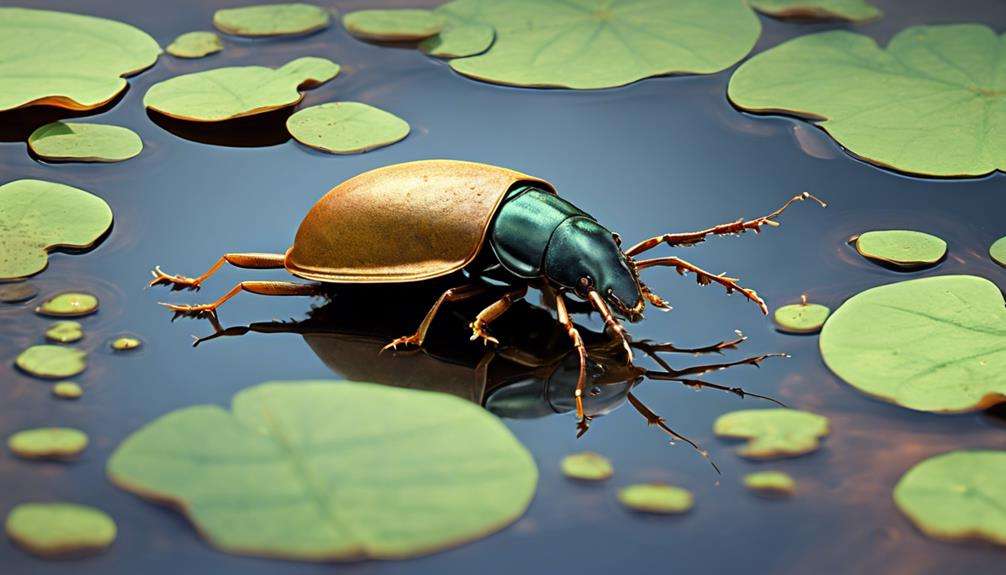
Water beetles engage in reproductive behavior through mating, involving the transfer of sperm from the male to the female for fertilization. Once fertilized, females lay their eggs in aquatic environments, attaching them to vegetation or other substrates. These eggs hatch into beetle larvae, which undergo several developmental stages before reaching adulthood.
Some water beetle species exhibit parental care, with adults guarding and providing for their offspring. Environmental factors such as temperature and water quality play a vital role in the success of water beetle reproduction.
It's fascinating to observe the intricate process of water beetle reproduction, from the initial mating rituals to the careful nurturing of the next generation. Understanding these reproductive behaviors can provide valuable insights into the life cycle and ecology of water beetles, making them even more intriguing pets to observe and learn about.
Behavioral Insights and Observations
In the enchanting domain of water beetle behaviors, one can observe a plethora of fascinating insights and observations that shed light on their unique adaptations and interactions within aquatic environments.
Predaceous diving beetles, known for their predatory nature, exhibit remarkable behaviors. These beetles are skilled hunters, using air bubbles to breathe underwater while they stalk and capture their prey. The air bubble, which they carry with them, serves as a portable oxygen tank, enabling them to stay submerged for extended periods during their hunting expeditions. Their frenetic movements on the water surface are calculated and efficient, showcasing their prowess in the art of underwater predation.
Additionally, the elegant swimmers among water beetles display mesmerizing agility and grace in their movements. With powerful mouthparts, they navigate through the water with precision, capturing unsuspecting prey with ease. These behavioral insights provide a glimpse into the fascinating world of water beetles and the intricate adaptations that have evolved to guarantee their survival in diverse aquatic habitats.
Handling and Interaction Guidelines
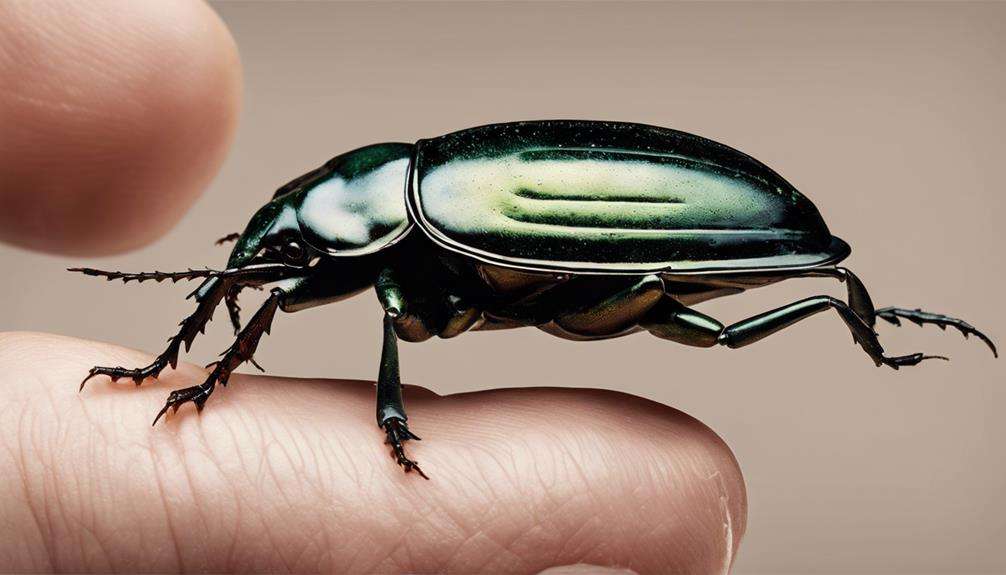
When interacting with water beetles, guarantee gentle handling and minimal sudden movements to promote their well-being and reduce stress levels. Water beetles are delicate creatures that can easily get stressed if handled roughly. To assure their safety, use soft brushes or gentle tools when interacting with them to prevent any harm. It's important to avoid excessive handling of water beetles as this can lead to injuries or increased stress levels. Remember to wash your hands thoroughly before and after handling water beetles to prevent any contamination that could harm them.
Creating a calm and quiet environment is important when interacting with water beetles. Loud noises or sudden movements can startle them, so it's best to provide a peaceful setting for their well-being. By following these handling guidelines, you can guarantee a positive interaction with your water beetles and help them thrive in their environment.
Common Health Concerns
To guarantee the well-being of your water beetles, it's important to be aware of common health concerns that could impact their overall health and longevity. Whirligig beetles, like other water beetles, are vulnerable to water quality issues. High levels of ammonia in the water can be harmful to these fascinating creatures, affecting their health and well-being. Additionally, parasitic infections by flatworms and nematodes pose a significant threat, leading to reduced fitness and potential mortality among whirligig beetles.
Toxic chemicals present in water bodies, such as pesticides and heavy metals, can have adverse effects on the health of water beetles, including whirligig beetles. These substances can disrupt their delicate ecosystem and cause harm to their populations. In addition, diseases like fungal infections can impact whirligig beetles, manifesting through symptoms like lethargy, discoloration, or abnormal behavior.
Stress induced by environmental changes, such as temperature fluctuations or habitat disturbances, can weaken the immune systems of water beetles, making them more susceptible to various health issues. It's important to monitor and maintain the quality of water to assure the well-being of your whirligig beetles.
Unique Characteristics of Water Beetles
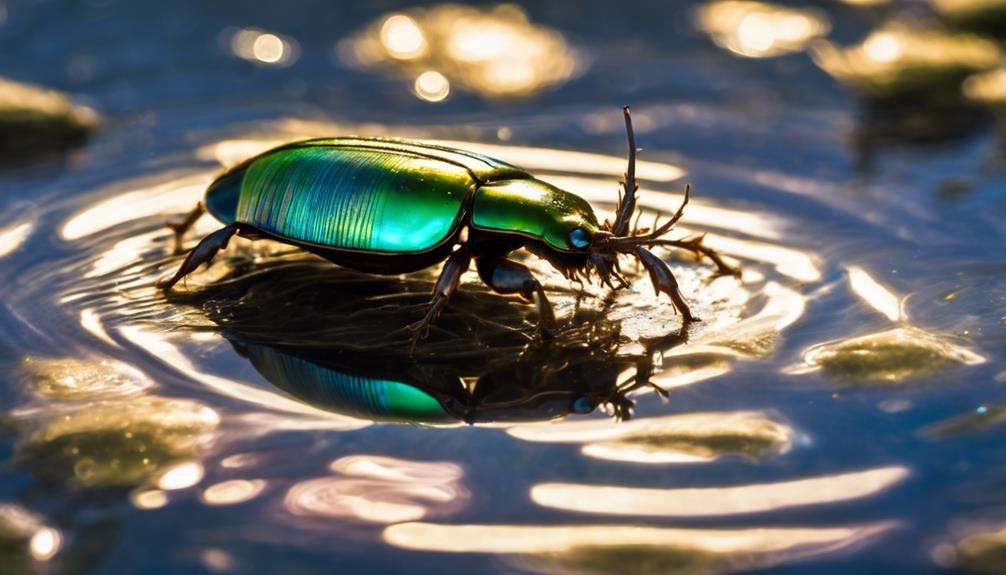
Water beetles showcase a myriad of unique characteristics that distinguish them as fascinating creatures adapted for survival in aquatic environments. One remarkable example is the Thermonectus marmoratus, a type of water scavenger beetle known for its ability to dive and remain submerged for extended periods.
Many water beetles carry an air bubble underneath their abdomens, serving as a crucial air supply and preventing water from entering their spiracles. Additionally, some species have a modified exoskeleton that forms a plastron, aiding in air retention. Certain water beetles possess physical gills that facilitate gas exchange with water, enabling them to respire efficiently underwater.
Notably, while most water beetle families have aquatic larvae, some species have terrestrial adults, showcasing the diverse life cycle adaptations within this group of insects. These unique characteristics not only highlight the ingenuity of water beetles but also underscore their important ecological roles in aquatic ecosystems.
Fun Facts and Trivia About Water Beetles
One fascinating aspect to note about water beetles is their diverse adaptations and intriguing behaviors that make them enthralling creatures to observe in aquatic environments. Water beetles have evolved various mechanisms to survive underwater. Many species carry an air bubble underneath their abdomens, serving as a portable air supply and preventing water from entering their spiracles. Some beetles possess a modified exoskeleton that forms a plastron, aiding in air retention. Additionally, certain water beetles are equipped with physical gills for efficient gas exchange with water, enabling them to protect in their aquatic habitats.
Exploring the natural history of water beetles reveals their remarkable ability to adapt to different environments. These adaptations not only safeguard their survival but also play essential roles in aquatic ecosystems. By understanding the characteristics and types of water beetles, you can gain a deeper appreciation for these fascinating insects and the intricate ways they interact with their surroundings.
Frequently Asked Questions
What Are Some Interesting Facts About Water Beetles?
Water beetles showcase fascinating adaptations for survival in aquatic environments. Their behaviors and physical features, such as air bubble storage, modified exoskeletons, and physical gills, allow them to thrive underwater, showcasing remarkable evolutionary strategies.
Can You Have a Beetle as a Pet?
You can have a beetle as a pet! Beetle care involves understanding their specific habitat needs and feeding habits. Creating a suitable environment with live plants and gravel is essential for their well-being. Enjoy learning about beetle behavior and providing proper care.
Can You Keep Diving Beetles as Pets?
You can keep diving beetles as pets, but remember: diving beetle care requires a proper beetle tank setup. Assure water quality, provide hiding spots, and feed them well. Enjoy observing these fascinating creatures in your home aquarium.
Are Water Beetles Helpful?
Yes, water beetles are incredibly helpful! They provide essential ecological benefits by aiding in pest control through consuming various prey. Their presence indicates water quality and contributes to nutrient cycling, playing an important role in aquatic ecosystems.
Conclusion
As you watch your water beetle gracefully glide through its aquarium, remember that these fascinating creatures are like tiny scientists exploring their underwater world.
Just as they adapt and thrive in their habitats, you too can learn and grow from caring for them.
Embrace the curiosity and wonder that water beetles inspire, and let their unique characteristics and behaviors spark a deeper appreciation for the beauty of nature.
